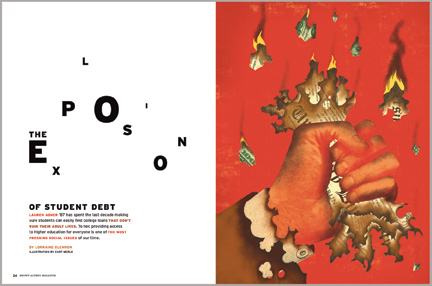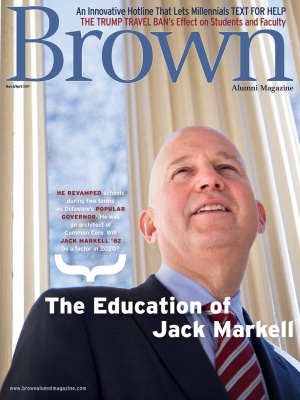STUDENT DEBT
Here’s one data point: I graduated from Brown in 1980 with about $10,000 in debt, which would be the inflation-adjusted equivalent of about $23,000 in 2004, or $29,000 in 2016, the two comparison years cited in Lorraine Glennon’s interesting “The Explosion of Student Debt” from the January/February BAM.

Debt forces individuals to make tough choices. If a good education is a human right, or if we believe in equality of opportunity, then something is amiss. Kudos to Lauren Asher ’87 for focusing on this issue.
Jeffrey Cochrane ’80
Comment from brownalumnimagazine.com
What is the average student debt upon graduation for Brown students?
Andrew Halvorsen ’68
Comment from brownalumnimagazine.com
Lauren Asher ’87 replies: According to data we at the Institute for College Access and Success collected as part of The Project on Student Debt, 34 percent of Brown’s 2015 graduates had student loans, and their average debt was $22,197. View state-by-state data at http://ticas.org/posd/map-state-data#.
MORAL LEARNING
I wanted to share an insightful comment made by Jennifer Hoffman ’89 on Facebook, in response to the article “1001 Black Men” (January/February): “I liked what you [Ajuan Mance ’88] said about your progression from drawing the sorts of men you encounter in your life to learning to see other types of men. Even for those of us who don’t do much drawing this is a good challenge: who do we see and not see, and how can we expand our vision?” I loved this point, and think it so critical. This has to be one of the reasons why drawing, or, more broadly, perhaps, artistic activity, are a critical part of learning—even “moral” learning, for lack of a better term.
Keith Greenbaum ’92 PhD
Comment from brownalumnimagazine.com
ELECTION FALLOUT
Compliments to Editor Norman Boucher, President Christina Paxson, and Deputy Editor Louise Sloan on their admirably well balanced comments on Brown’s response to the recent U.S. election and to Brown’s observance of Veteran’s Day (January/February).
The real hero, of course, is U.S. Marine and student Jonathan Hagedorn ’19, who not only honored and defended the U.S. flag, as he has been trained to do, but also took time to explain to fellow students the real significance of Veteran’s Day and why it is important to the Brown community. May Brown be blessed with more such heroes.
Tom Rollinson ’60
Clovis, New Mexico
[email protected]
In reference to the harvesting of the flags: “These were University flags put out for a University event honoring veterans” (“After the Election,” From the President). By putting them out, the University took sides in a fight it could have stayed out of. Patriotism and flags are a secular religion in the United States, and people resist having another’s religion forced upon them. Those who think of all war victims as victims of politicians on all sides would disapprove of little flags dedicated to just some of them.
Charles W. McCutchen ’52 ScM
Bethesda, Md.
[email protected]
The new U.S. president has indeed struck fear in “Muslims, immigrants, people of color, and so many others left isolated and frightened by the election campaign and its aftermath,” as the editor and publisher wrote in the preface to the latest issue (“What the BAM Can Do,” Here & Now). But in that recitation, how could the BAM forget half the population—women—which includes so many graduates of Brown?
What can the BAM do? For starters, please don’t leave me out. It makes me really, really sad. And there’s so much more for me to be sad about these days.
Margaret E. Murray ’80
San Francisco
[email protected]
It saddens me deeply to read of the Veteran’s Day flag destruction on the College Green last November 10. I am a graduate and a veteran of twenty years in the U.S. Marine Corps who served three combat tours in the Iraq War, and I am decorated for valor as both an aviator and an infantry marine. I have numerous friends buried in Arlington and other national cemeteries.
I am disappointed in the “well-heeled” ignorance of the students who uprooted the flags. This world is real, not ideal. Unfortunately, an idealistic youth all too often forgets or simply doesn’t understand the luxury of America. My existence may be grotesque to the Brown student body, but it is necessary for and respected by the majority of citizens in this country. The very rights these students so poorly express are defended by marines like me. I think I’ll change my license plate frame from “Brown Bears” to “Veteran USMC.”
Roy Moore ’96
San Diego
I do not think it was necessary for the publisher of the alumni monthly to state that he voted for the Clinton woman. He voted for Hillary, as was his right. But was it necessary to focus so many pages on the election? Is it possible for Norman Boucher to “man up” and admit that many people do not like Clinton or what she stands for?
Now that Trump is president, I can actually use those words and that is a good thing! Those of us who voted for the guy who won are going to think twice before sending in donations to a campus that is intolerant of politically incorrect beliefs and divergent opinions. If you want to know why Clinton lost, read the first few articles in the January/February BAM. It is a tribute to political correctness gone wild. Now go back to your coloring books and safe spaces.
Alice Lemos ’81 PhD
Woodside, N.Y.
AGEISM AT THE BAM?
What’s with the “Even” in the subtitle to the article in the January/February print issue about my classmate—“Even at 70, Jon Turk ’67 is addicted to high-risk exploration” (“The Adventurer,” Classes)? That implies we are not to explore, pursue adventure, and keep living wildly at 70. Somebody forgot to tell a lot of us about that rule.
Alice Cannon Vilardi ’67
Hayward, Calif.
CORRUPTOR OF YOUTH
Professor Emeritus of MCM, English, and Comparative Literature Robert Scholes was my most important teacher. He combined a fearsome intellectual discipline with an open-minded enthusiasm. That meant he insisted on getting the details of a text right (I never use the word rigor without thinking of him stressing it all through a Derrida seminar I took senior year) while also being jovially open to the crazy notions of undergrads.
He taught me a relish for theory, and he humored and extended my work on James Joyce in an extraordinarily generous way. I still think about the Scholes paper: one page, any font, any margins. It was a brilliant, organic way to teach us how to edit. And I have taught his book Textual Power to my own graduate students for years.
Bob, thank you for being a model of generous, warm, patient excellence. I went to Cornell for grad school because he did, and he told me that the great thing about Cornell was that, whenever the students walked in a certain direction, the school recognized that fact and laid down a pathway. I don’t know if that’s true of Cornell, but it’s true of Bob Scholes. Thank you for treading ahead and making a pathway for your students. The world is poorer now that you’re not in it.
Talia Schaffer ’90
Comment from brownalumnimagazine.com
I will greatly miss Bob Scholes. I first met him when we were on opposing sides, or so we thought, in the critical wars of the 1970s and 1980s, but from talking through them we became friends and, I felt, intellectual allies.
For many, Bob and his work were absolutely crucial in helping us understand the baffling and seemingly alienating new theories and methods that exploded in those years. His 1985 book Textual Power was and is not only a most clarifying discussion of those theories and methods but, for me, the most useful available guide by far on how to use them in teaching, which was always Bob’s bottom line. Bob was always friendly, warm, and funny, and I loved the times I (and later my wife, Cathy, and I) spent with Bob and his wife, JoAnn.
Gerald Graff
Comment from brownalumnimagazine.com
The writer is a former president of the Modern Language Association.
When Bob Scholes put up his Facebook page in 2009, he told me he did it only because his former students wanted to connect with him there. But soon he was posting pieces of new things he was working on, photos of himself all over Asia during his U.S. Navy years, and on March 5, 2012, a fabulous essay entitled “Corruptors of Youth,” which begins: “I am one of those college professors feared by Senator Santorum as corrupters of safely indoctrinated young people in colleges.” The essay itself is witty and brilliant, and the back-and-forth comments between Bob and his students are hilarious. As one of the many proudly corrupted by Bob, I commend that posting to all of you in tribute to him.
John Braunstein ’79
Comment from brownalumnimagazine.com
When someone asks me what was special about my time at Brown, I immediately reply: “That would have to be the Group Independent Study Project I organized around Joyce’s Ulysses, which met once a week at Bob Scholes’s home on Power Street with an eager coterie of six curious and committed undergraduates.”
There, after a splendid dinner prepared by Bob’s lovely wife, JoAnn, we worked our way through the greatest novel of the twentieth century. (I’m exercising some license here as the first and only Anglo-Irish Literature major to graduate from Brown.) Chapter by chapter, often line by line, Bob was our passionate and trenchant guide to my namesake’s journey throughout Dublin on June 16, 1904. I’ve never had a more engaging and joyous learning experience in my life.
Few know this about Bob: In 1970 I returned from a semester at Trinity College Dublin with an English edition of Sylvia Plath’s The Bell Jar. Of course, I asked Bob to read it. As a result, he helped to confront the longstanding Plath family censorship of the work and ultimately arranged to have it published in the United States for the very first time.
Bob was supremely gracious, encouraging, and kind. He was an inspiring teacher who could not wait to share his wide-ranging enthusiasms, whether they were new films, travel tours, or professional sports. It was my great, enduring fortune that Bob became my friend.
Bob knew that literature matters. And you could tell by the ever-present twinkle in his eye that he wanted you to know the same.
David W. Bloom ’71
Comment from brownalumnimagazine.com
NEUSNER'S CLASSROOM
I write in memory and appreciation of Judaic studies professor Jacob Neusner after his recent passing at age 84. When I was at Brown in the early 1980s, I knew Professor Neusner’s reputation as one of the most prolific and controversial Judaic scholars of his generation. That aspect of his life has been well reported in obituaries in many major papers.
Professor Neusner was also one of the most interesting and effective teachers I ever had. For a college student, Professor Neusner’s classroom was a unique challenge. The texts and concepts were often difficult, but that was not what distinguished his classes. He set a high standard for discussion and did not tolerate lack of participation. Sitting in the middle of the classroom in a swivel chair, with twenty or twenty-five students sitting in a circle around him, Professor Neusner was Socratic, demanding, and thoughtful; he always relished, and even invited, well reasoned disagreement. His goal was not to persuade, but to engage every student in making and defending as strong an argument as possible.
Professor Neusner took an unusual interest in his students. He spent considerable time marking up papers of mine and then going over his comments with me one-on-one. This was not drudgery left to his TAs; for him, it was the professor’s job. I am a far better writer today because he coached me more than thirty years ago. I recall being invited to his home for dinner with his family, as most of my classmates were. And I recall later, when I was editor of the Brown Daily Herald, getting more than one call or note from Professor Neusner because he agreed or disagreed with something we had written.
Professor Neusner left Brown in 1989 and continued teaching until 2014. Among his many accolades, he should be remembered for his positive impact on many a Brown education.
Peter B. Krupp ’83
Needham, Mass.
[email protected]
TASTES IN POETRY
In reference to “Poetry Redux,” letter from Peter Gale Nelson, January/February 2017: Professor Nelson’s loyalty to his colleagues and his profession is impressive, but, if he had read my November/December 2016 letter carefully, he would have seen that it does not imply that “today poetry is a worthless undertaking perpetrated by a gang of lazy frauds” (“Poetry Redux,” Mail Room, January/February). Saying,
It often involves
Overwritten and banal sentences
Chopped up to
Look
Like
Free
Verse
implies nothing about laziness, nor, since often is a long way from always, does it imply that contemporary poetry is worthless. In particular, it is compatible with admiration for the excellent William Carlos William poem Professor Nelson quotes, and it certainly does not “mock with glee” such a poem.
Moreover, while many poets may be, as Professor Nelson puts it, “marginalized in this extended commercial republic,” this hardly applies to those, such as the ones he mentions in his letter’s next-to-last paragraph, who have been privileged enough to be tenured professors at Brown.
Felicia Nimue Ackerman
Professor of Philosophy
Campus
FR. O'SHEA'S LEGACY
It was with great sadness that I learned in the September/October issue of the death of Fr. Howard O’Shea. Fr. O’Shea was an extraordinary chaplain, the first to minister to Catholic students, faculty, and staff at Brown.
While working at the Franciscan mission in downtown Providence, Fr. O’Shea simply walked up College Hill and began ministering to a group that had grown substantially in the late 1960s. He had no official appointment, office, or title. He was soon welcomed by Brown’s Protestant chaplains, but because Manning Chapel was already booked Sunday mornings for Protestant services, there was no time or space for weekly masses. In typically creative fashion, Fr. O’Shea simply universalized a time Catholics usually only experience on Christmas Eve. Weekly mass was scheduled in Manning at midnight on Saturdays (with beer and donuts served downstairs afterwards).
It was Fr. O’Shea’s Franciscan zeal for life that drew often standing-room-only crowds to those midnight masses. He did not hesitate to show that he loved creation, students, and God. During a period of major change in the Catholic Church, he did not hesitate to make changes on a small scale for Catholics at Brown. For example, instead of using regular flat plates for the collection, he had us use large waxed paper buckets (like those at KFC but without markings), announcing each year that there might be times when students, some of whom were new to budgeting, would need to take money out of those buckets.
I feel blessed that I was one among many recipients of this visionary Franciscan’s ministry during a formative period of my life. May Fr. O’Shea OFM rest in the bosom of Abraham.
Gordon J. Hamilton ’74
Toronto, Canada
[email protected]
THE PRIEST AND THE ENGLISH PROFESSOR
I write with my own concerns about the lack of substantive coverage for the passings of Rev. Howard O’Shea and Professor Sears Jayne. Father O’Shea welcomed me, a non-Catholic, with open arms and gave great comfort through many difficult times. Whether or not he held a faculty rank, he taught me and other Brown students of the era many important life lessons—perhaps more important lessons than those we learned in classes.
English professor Sears Jayne was such a legendary professor that I went out of my way to enroll in one of his classes, despite having chosen Brown specifically because the curriculum didn’t require me to take English courses (Obituaries, November/December). I still treasure the commonplace book I created, and remember our discussions of my selections. Both of these gentlemen (and I use that term intentionally, as they were true gentlemen) had a significant impact on me, though neither worked in my major areas of study.
A key factor of a great university is its faculty. It is clear from the letters in this magazine that Brown alumni treasure their former faculty and want to see their careers substantively honored in this publication. I hope the editorial staff will take this feedback to heart and give more attention to these matters in the future.
Victoria Kaprielian ’81
Durham, N.C.
[email protected]
PIONEERING VINTNERS
You can add me to your list of wine-making Brunonians (“The Noble Vine,” Mail Room, January/February).
Some history: Around 1952, University of Washington professors Lloyd Woodburne and Phil Church began making wine at home. They soon grew to a group of ten who made wine from grapes, mostly zinfandel, shipped by boxcar from California to Seattle’s large Italian community. The group, known as The Associated Vintners or AV, wanted to determine whether or not vinifera grapes would grow well and make good wine in Washington, so Phil Church, a meteorologist, scoured the state for an ideal spot to plant a small vineyard. He chose a five-acre plot in Sunnyside in the Yakima Valley, and on it in 1961 AV planted the first vinifera vineyard in Washington and jump-started the Pacific Northwest fine wine industry, planting six varieties from cuttings obtained from UC Davis: cabernet sauvignon, merlot, Johannesburg riesling, gewürztraminer, chardonnay, and chenin blanc.
The first vintage, in 1967, was delayed by a 1964 frost that killed the vines but not the roots. The sales of the 1967 whites in 1969, and the reds a year later, were a spectacular commercial success, so Associated Vintners bought eighty more acres in the 1970s. AV later morphed into the Columbia Winery. Six of the ten original founders were professors from the University of Washington. As a professor in the Department of Chemical Engineering, I was one of those ten.
At 92, I am now the sole AV survivor. Today Washington is second only to California in the production of vinifera wines.
Seattle
Shona proposed a drive up to the Le Clos du Gravillas vineyard in the truly tiny village of Saint-Jean-de-Minervois, where John Bojanowski ’88 and his wife, Nicole, from Narbonne, are producing organic wines from grapes that are cultivated and harvested mainly by hand. John and Nicole make a number of different wines, including a Muscat, a grape that made the village famous, but they have also had an important role in reviving the reputation of the carignan grape. For many years carignan was overplanted in the region due to its high yields, and, without the necessary attention to quality, many of the wines produced from it were not the most admirable.
Recognizing the value of focusing on smaller yields and allowing the grapes time to ripen fully, John has been a leader in restoring the carignan’s reputation. The couple’s 100 percent carignan wine, Lo Vièlh, has won high marks. We had a full tour of the vineyards and a convivial (how could it not be?) tasting of the gamut of wines produced by Le C du G in the degustation room out back.
Many thanks to vintner Colin Knudsen ’79 and his letter that suggested cataloging Brunonians around the world who are involved in this timeless and joyful enterprise.
Diane Donaghey Jumet ’70
New York City
[email protected]
CORRECTIONS
The father of Deborah Ross ’85, who lost her U.S. Senate race in North Carolina, was not a U.S. Air Force pilot. (“In the News”, Classes, January/February). He was in fact a physician stationed with the Strategic Air Command in Nebraska during the Vietnam War.
Bob Ladd ’68 will travel to Providence for the graduation of his son Carlo R. Ladd ’17 and not of a daughter, as classmate Don Lusardi mistakenly reported. (Classes, January/February).





